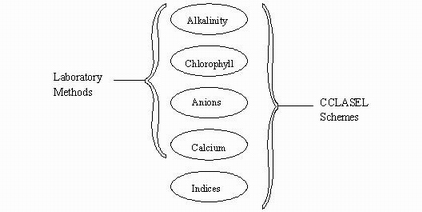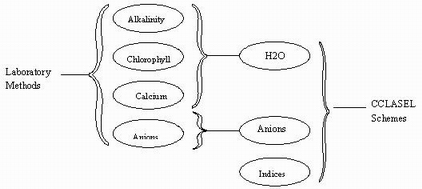Maintaining Schemes
Overview
A scheme defines the analytical test applied to samples, sub-tasks within a scheme, miscellaneous procedures or preparation prior to analysis. Schemes are added to and template jobs to specify the analytical requirements on samples. Different sections of the laboratory, or even different clients, might use different schemes.
A method is the method the laboratory uses for analysis. A scheme is the representation of a method in CCLAS EL. A layman’s example is as follows. A water laboratory uses these methods to analyse their samples: Alkalinity, Chlorophyll, Anions and Calcium (amongst others), so these exist as methods in the laboratory, as well as schemes in CCLAS. It means that, as soon as analysis is done using these methods, the results are captured into CCLAS EL using the corresponding schemes. The link between CCLAS EL schemes and the laboratory’s methods is contained in the SCHEMES table. Assume only calculations across these methods are reported, but not the methods themselves. Then one could create a separate scheme (for example, called Indices) in CCLAS EL, where all the calculations across the methods are stored.

Theoretically, the Indices scheme is also a method in the Laboratory, because there should be clear guidelines on how calculations across other methods are performed. Practically, the Indices scheme will only exist in CCLAS EL, because CCLAS EL is performing the calculations to populate the Indices scheme.
Alternatively, all the methods above are use to analyse water. The methods Alkalinity, Chlorophyll and Calcium have only one analyte each. The laboratory would still have these methods as methods of analysis in the laboratory. However, in CCLAS EL there might be only one scheme called H2O. The H2O scheme might then contain Alkalinity, Chlorophyll and Calcium as analytes.

This process is pertinent to laboratory and QC managers who configure the analytical environment for the laboratory.
Scheme Versions
Schemes are versioned to allow for updates in the method, or application of the method.
- Versioned schemes have the same scheme code.
- Once an existing version becomes outdated, the parameters of that version remain untouched so that those samples analysed under it still have a reference.
- Saving a scheme to a new version of the scheme does not affect existing data captured against the original scheme version.
- The LIMS is configured to either show all scheme versions or only the latest scheme version when schemes are located during job registration.
- A scheme contains analytes that hold information, such as, expected values, statistical determinations, detection limits, formulae, etc, anything required to obtain a result.
Scheme Types
Schemes are separated into scheme types, either:
- ANA (Analytical)—Specifies the quality control and analytes for analysis.
- PRP (Preparation)—Specifies the preparation and sample splitting requirements for samples to be analysed.
- HDR (Handler)—Contains scheme sub-tasks, to assist with the recording of data related to analysis, for example, the recording of dates for digestion, dilution, instrument reading and QC review. These tasks are distinct to preparation schemes that have in-built functions for duplicate creation, and are marked completed when analytical schemes are started.
- MIS (Miscellaneous)—Adds in extra non-analytical or preparation procedures that are invoiceable.
Scheme Pricing Structure
Schemes are created with a pricing structure, either:
- ANA (Analytical)—Based, based on analytical results of each sample.
- HLY (Hourly)—Based on hourly rate and number of hours for the job scheme.
- SCH (Scheme)—Based on number of analytes, by sample for the job scheme.
- SMP (Sample)—Based on number of samples for the job scheme.
Linked Schemes
Schemes are linked together in jobs so that weights and volumes are transferred from one scheme to the other:
- Link scheme relationships are established in the job.
- Typically, a job scheme that is a digest-only scheme is the parent scheme of the linked job schemes. Its weight and volume are captured in the Weight/Volume mode in the Data Entry application.
- The child linked job schemes receive the weights and volumes from the parent job scheme. Note that a parent job scheme can have multiple child linked job schemes.
- Samples are then analysed using the analytical scheme, where the weights and volumes from the parent scheme are used for Weight/Volume correction. The transfer of weights and volumes between linked schemes happens automatically.
- To ensure that weights and volumes are transferred from job scheme to job scheme, the rack layouts (including the quality control samples) is identical for linked schemes.
- If the weights and volumes are captured or entered into a parent scheme initially into a laboratory batch job, then these are not transferred to the child schemes in the parent job, unless these child schemes are also within the same laboratory batch job.
- The LIMS may be configured to automatically update the weights of samples in linked schemes when a sample weight is captured for a parent scheme in a job.
Quality Control definitions in Schemes
Quality control parameters of a scheme define the blank, quality control (QC) standard, QC spike, replicate and re-read requirements:
- A QC standard sample type is a known sample, typically an international standard material or a very-well blended and measured in-house developed standard material. The results of a standard QC sample are measured against the known limits of the standard materials to ensure the quality of analysis, verifying that the calibration of the instrument is correct, and used to apply a correction factor for results issued from the instrument.
- A blank sample type is literally blank. The analyst uses a clean solution (for example, for WetChem analysis, the solution contains all the titrants and solutions, but not the analyte that is to be analysed). Naturally, the expected value of that blank sample should be +- 0.
- The blank sample is used to verify that the calibration of the instrument is correct. It also supplies a correction factor for results issued from the instrument. For example, if the reading on this blank is 0.2%, then the readings of the unknown samples should be lowered by 0.2%.
-
Spiking involves analysing a sample that has a slightly heavier amount of standard material added to it, and expecting the same pro-rata result. If this expectation is not met, then the quality control has failed on that spike sample.
- A replicated sample is where two samples are created from one original sample and then each separately prepared and analysed on the instrument.
- Rereads are already read and stored immediately after the original sample so that the system can calculate the actual result from all of the reread results. If the results are close enough to each other (set by limits), then the quality control has failed on that sample.
Process
Schemes are maintained using the Method application. You need specific rights to have visibility to this application.
Schemes are maintained using simple SCRUD (search, create, review, update, delete) functionality under the Methods » Scheme codes node. You need specific rights to have visibility to this node.
Your system may be configured to create static data audit records upon any change to a scheme. These records can be seen by Reviewing Static Data Audits.
A scheme with a Scheme Type of ANA (Analysis) contains multiple analytes that are used to hold precursors to results, or the results themselves.


